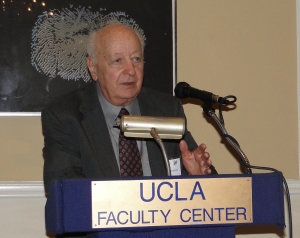John Riley On Harold Demsetz

Harold Demsetz
Professor Harold Demsetz will be greatly missed by all who were either his friends, his students, his colleagues, or, in my case, all three!
Harold grew up on the West Side of Chicago. He received his B.A. (1953) and MBA (1954) from the University of Illinois. In 1958 he was awarded a Ph.D. in Economics from Northwestern University. He taught at the University of Michigan (1958–60), UCLA (1960–63), and the Chicago Business School (1963–71) before returning permanently to UCLA’s Economics Department.
Harold was a true giant of the profession. He was a leading figure in the Chicago school, and was one of the pioneers of the approach now called New Institutional Economics. He is a founder of the field of managerial economics. He expanded the theory of property rights now prevalent in law and economics. Even though Harold never employed game theory, he is a major figure in industrial organization through his writings on the theory of the firm, antitrust policy, and business regulation.
Over his lifetime, his papers garnered over 63,000 citations. This is a stunning number. Harold’s most famous paper (“Production, Information Costs, and Economic Organization,” written with his colleague Armen Alchian for the American Economic Review in 1972), has over 18,000 citations. It is one of the most cited papers in all of economics. His next nine most cited papers were all cited over 2000 times. The titles of some of these papers provide a glimpse of the depth of his research on the theory of the firm:
- Toward a theory of property rights,
- The structure of ownership and the theory of the firm,
- Industry structure, market rivalry and public policy,
- The cost of transacting,
- Why regulate utilities?,
- The property right paradigm,
- Information and efficiency: another viewpoint.
I arrived at UCLA in 1973. Harold had just started UCLA’s first field focused research (the IO workshop) and a string of luminaries were invited to make their presentations. It would not take many minutes before Harold would ask his first question and usually there was a follow-up question as well. This was exciting stuff for students and faculty and as an assistant professor it was an essential part of each week.
Knowing that I was writing on the theory of signaling, Harold arranged for me to give a talk on the topic at the Chicago Business School. It was understood that surviving this was a necessary condition for earning his respect as an economist. A talk on competition with private information of course generated a huge amount of discussion at the workshop so I did not have to talk too much. It was a huge confidence boost for a young assistant professor!
Not surprisingly, Harold attracted a large number of students to his graduate classes and deeply influenced many of their doctoral dissertations. He also had a strong influence on undergraduate education. Around 1980 he stimulated on ongoing lunchtime faculty club debate on how to best teach economics to undergraduates. If the vast majority were seeking jobs in business, why were we not offering a program designed to prepare them to understand finance, theories of firm boundaries, the regulation of monopoly, and so on? Not only would this be good for the students but it might also attract funding for the department. In 1983, as a result of Harold’s determined leadership, a new major in Business Economics was born and it proved wildly popular. Very high entry barriers were established and it quickly became a quasi-honors program for the economics undergraduates. Businesses took notice both in their recruiting efforts and in their financial support. In particular Arthur Anderson funded the Arthur Andersen UCLA Alumni Chair in Business Economics. Of course Harold was by far the most distinguished candidate! Thirty-five years later, the Business Economics Major continues to attract exceptional students.
I will conclude with another vivid personal memory. It begins with Harold carrying his sneakers as he headed down the elevator at lunchtime. “Off to run at the track!” he told me. I was invited to join him some day. I agreed and as we arrived at the starting point he said, “John this is your first time, so don’t feel you have to keep up with me.” While it was a crisp pace I realized that I could keep up with my very senior (42 year old) colleague. I decided to do some training with the goal of being able to lap him in a 2 mile race. I completed my preparations and challenged him. It seems stupid now! The day arrived. I had a simple plan. Sprint the first lap, get a big lead and watch Harold give up. Away I flew. 440 yards later he was still right on my heels. I was the one who knew I was going to fall short and so I did. Harold always recalled this event with great satisfaction even though he admitted it was one of the hardest things he had done in his life! But that day proved much more important. It was the beginning of a long and close relationship. We were often competitive but always good friends.
By John Riley

